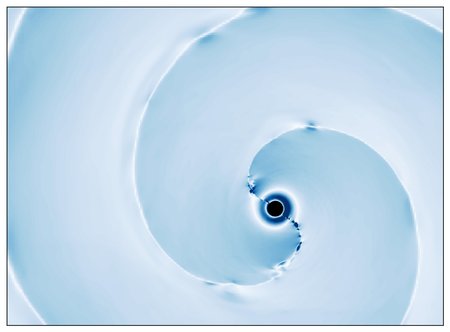Over the next couple of weeks two eclipses will be taking place. Early on the morning of Tuesday, Nov. 8, the moon will plunge completely into the shadow of the Earth producing a total lunar eclipse that will be visible from North America as well as parts of South America, central and eastern Asia, Australia and New Zealand.
But as a prelude, two weeks prior to this event, on Tuesday, Oct. 25, the new moon will orbit between the sun and the Earth, causing a partial eclipse of the sun to take place.
To produce this upcoming eclipse, the moon’s shadow will scrape the north polar regions of Earth. (opens in new tab) It will be visible from an eastern slice of Greenland and all of Iceland, as well as most of Europe (except Portugal and the western and southern portions of Spain), northeast Africa and over much of western and central Asia. Even if you don’t live in these areas, you’ll luckily be able to watch the partial solar eclipse online thanks to several free livesteams. We will also host it free here at Space.com.
Related: How to watch the last solar eclipse of 2022 online next week (Oct. 25)
Greatest eclipse – with nearly seven-eighths of the sun’s diameter (86.2%) hidden – occurs at local sunset over the West Siberian Plain near the city of Nizhnevertovsk (pop. ~260,000), one of the wealthiest cities in Russia.
The rest of the eclipse zone will see less of the sun covered. For much of eastern Europe, including western Russia, Finland, and northern portions of Sweden and Norway, as well as Ladakh, Jammu and Kashmir in India, more than 60% of the sun’s diameter will be covered by the passing new moon.
Across east-central Europe, including Denmark, Poland, Romania, the Balkans as well as most of the Middle East and western India, the eclipse magnitude diminishes to 40% to 60%.
For Iceland, as well as much of the United Kingdom, Germany, eastern France, Italy, Greece, Egypt and southwest India, the magnitude diminishes further, down to 40% percent, while for western France, northeast Spain, Libya, Sudan, Ethiopia and Somalia, less than 20% of the sun’s diameter will be eclipsed.
In fact, for some cases such as Valencia, Spain and Algiers, Algeria, the edge of the moon will only cause a barely perceptible dent on the upper part of the sun’s disk; Madrid is just outside the eclipse zone and will not see anything. Portugal is the only European country that will be shut-out of the event, being situated just outside of the eclipse visibility zone.
For western Europe this is a morning event; midday for central Europe and early afternoon for eastern Europe. Going farther east, over western Russia and India, the eclipse occurs during the late-day hours with sunset intervening for some before the show concludes. Across central India, for instance, maximum eclipse will coincide with sunset, while farther to the east, the moon will only begin its encroachment onto the sun’s disk as it sets.
For those locations where more than half of the sun’s diameter will be covered it is debatable whether this will be enough to noticeably dim the sky and landscape. But some might still attempt to record the gradual fading and recovery of the sunlight with sensitive photographic exposure meters. These can be set to view a light-colored wall that directly faces the partially eclipsed sun.

Be careful!
Unlike a total eclipse of the sun, concentrating its excitement into a few fleeting minutes, a partial eclipse can be watched easily from wherever one happens to be. Observations can be made with the naked eye, binoculars, or telescopes of any size. Of course, during any direct observation of the eclipse, eye or camera must be protected by dense filters from the intense light and heat of the focused solar rays. Keep in mind that the sun is no less dangerous to look at during a partial eclipse than it is on a normal sunny day. Unless the sun is very low and appears dull red, don’t be tempted to squint at the spectacle or steal unsafe glances just because part of the sun’s surface is blocked by the moon.
More safety details on how to watch eclipses safely can be found in our guide on how to observe the sun safely.
Pinhole eclipses
Persons not expecting the event will probably not notice it, although some night see the peculiar shape of “pinhole” images of the sun cast by trees and bushes still in leaf. Indoors, closed Venetian blinds in a sun-facing window may produce rows of such images, where sunlight passes through small openings. Also, a small hole pierced in a dark shade will cast a sizeable eclipse image on a wall, floor or screen. Thus, even a person confined indoors can watch this celestial phenomenon.
Local circumstances
In the table below are local times including the greatest magnitudes of partial eclipse for fifteen selected cities. Magnitude is the fraction of the sun’s diameter covered by the moon. Dashes indicate that the sun is below the horizon.
These calculations were made exclusively for Space.com by Joe Rao, utilizing the website Eclipsewise.com (opens in new tab)
| Location | Eclipse begins | Maximum magnitude | Eclipse ends |
|---|---|---|---|
| Amsterdam | 11:07 a.m. | 12:04 p.m. .331 | 1:02 p.m. |
| Athens | 12:36 p.m. | 1:44 p.m. .377 | 2:51 p.m. |
| Berlin | 11:09 a.m. | 12:14 p.m. .435 | 1:19 p.m. |
| Cairo | 12:00 p.m. | 1:09 p.m. .369 | 2:16 p.m. |
| Kyiv | 12:23 p.m. | 1:37 p.m. .607 | 2:50 p.m. |
| London | 10:08 a.m. | 10:59 a.m. .258 | 11:51 a.m. |
| Moscow | 12:24 p.m. | 1:39 p.m. .709 | 2:51 p.m. |
| New Delhi | 4:29 p.m. | 5:30 p.m. .542 | —- |
| Oslo | 11:04 a.m. | 12:08 p.m. .502 | 1:13 p.m. |
| Paris | 11:12 a.m. | 12:02 p.m. .238 | 2:54 p.m. |
| Reykjavik | 8:58 a.m. | 9:46 p.m. .306 | 10:35 a.m. |
| Riyadh | 1:31 p.m. | 2:42 p.m. .447 | 3:47 p.m. |
| Rome | 11:26 a.m. | 12:21 p.m. .262 | 1:19 p.m. |
| Stockholm | 11:08 a.m. | 12:15 p.m. .563 | 1:23 p.m. |
| Tashkent | 3:23 p.m. | 4:35 p.m. .747 | —- |
Next year: A “ring of fire” for the Americas!
Less than a year from now, on Saturday, Oct. 14th, 2023 (opens in new tab), the moon’s shadow will sweep over the Western Hemisphere and almost completely envelop the continents of North and South America. More importantly, the path of an annular or “ring” eclipse will sweep southeast through western and southern portions of the United States, the Yucatan Peninsula of Mexico and Central America and then across southern Colombia and northern Brazil. While nearly a billion people will witness varying degrees of a partial eclipse, those within the path of annularity will see the sun morph into ring of sunlight lasting for up to 5.3 minutes.
But for many, next Oct. 14th will also provide a rehearsal for the BIG event of 2024: The Great American Total Solar Eclipse, which will occur on April 8 of that year and will cross parts of Mexico, the United States and Canada. Although lacking many phenomena peculiar to a total eclipse, an annular or partial eclipse nonetheless provides an excellent opportunity to try out instruments and procedures.
Looks like some very exciting times lie ahead. Mark your calendars!
Joe Rao serves as an instructor and guest lecturer at New York’s Hayden Planetarium (opens in new tab). He writes about astronomy for Natural History magazine (opens in new tab), the Farmers’ Almanac (opens in new tab) and other publications. Follow us on Twitter @Spacedotcom (opens in new tab) and on Facebook (opens in new tab).


